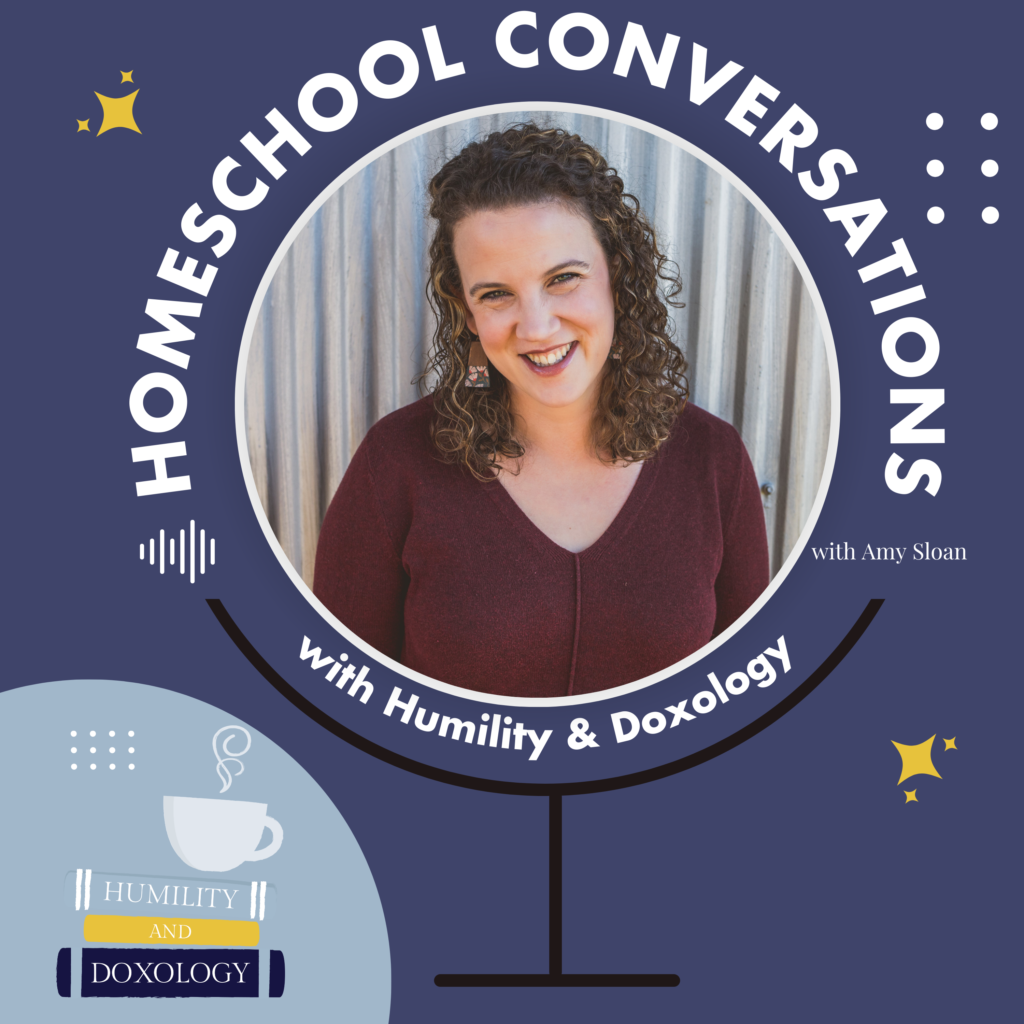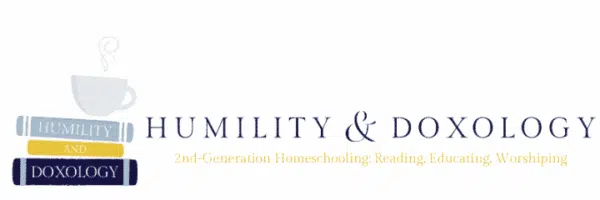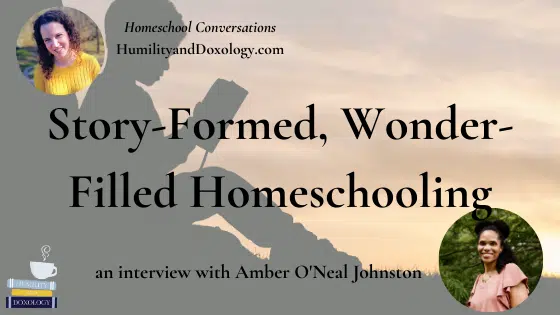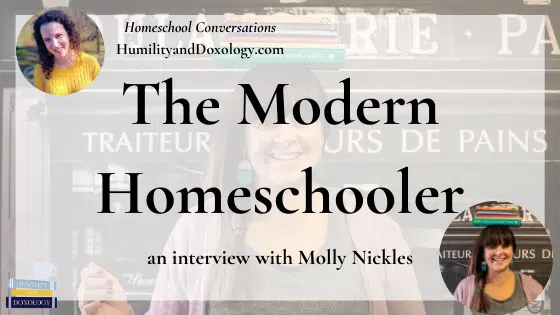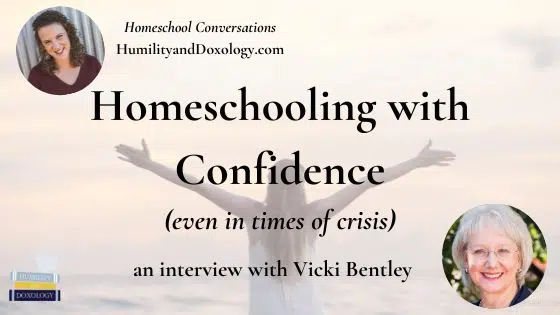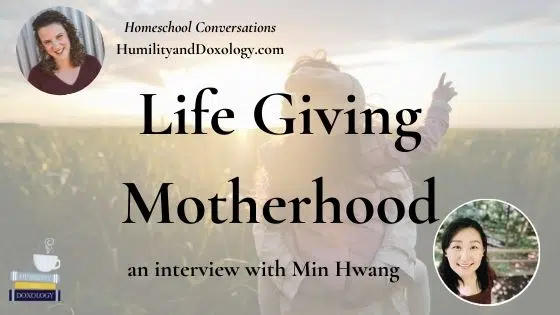I’ve absolutely loved following Amber Johnston on Instagram. I enjoy seeing pictures of her family exploring the world through travel, reading, and just ordinary family living. I appreciate her reminders that this homeschool mom life we’re living is a good gift. So it was such a delight to chat with her for this episode of Homeschool Conversations! We discussed topics like how she came to embrace a Charlotte Mason education; the value of cherishing a slow, gentle childhood; the concept of books as mirrors and windows; and the encouragement that you don’t have to figure it all out at once. I hope you enjoy this conversation as much as I did.
Be sure to check out all the other interviews in our Homeschool Conversations series!
Watch the video. Listen to the podcast. Read the show notes. Share with your friends!
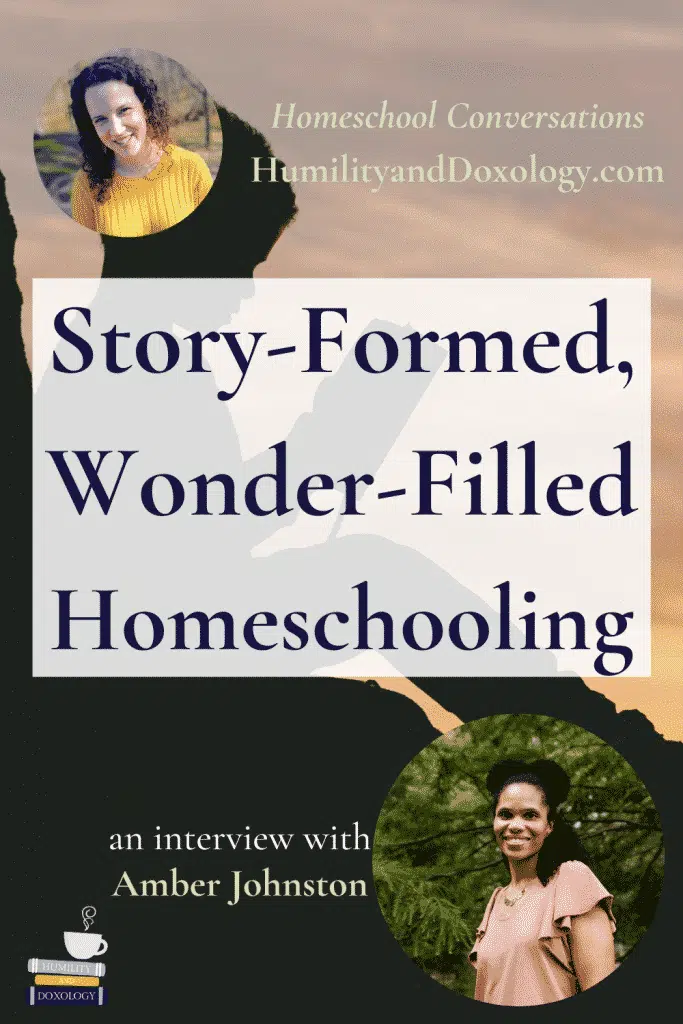
{This post contains paid links. Please see disclaimer.}
Who is Amber Johnston
Amber O’Neal Johnston fell in love with the principles of Charlotte Mason when her oldest was a preschooler. After wholeheartedly committing to follow Mason’s philosophy, she became disheartened when months went by with little mention, if any, of the stories and accomplishments of Black people in her school room. The literary quality of the books was better, but she found that the cultural emptiness she experienced as a schoolgirl was being perpetuated within the walls of her own home.
Committed to bridging the gap for her four children, Amber has embarked on a journey of uniquely merging living books with life-giving books and a culturally-rich environment to ensure that their education is not a legalistic venture in Charlotte Mason but an honest experience that honors the Truth while helping her children to see value in themselves and others.
Amber shares her observations on culturally-rich home education, books, travel, and more at www.HeritageMom.com, and when asked about her path she likes to smile and say, “In my house, Charlotte Mason has an afro.”
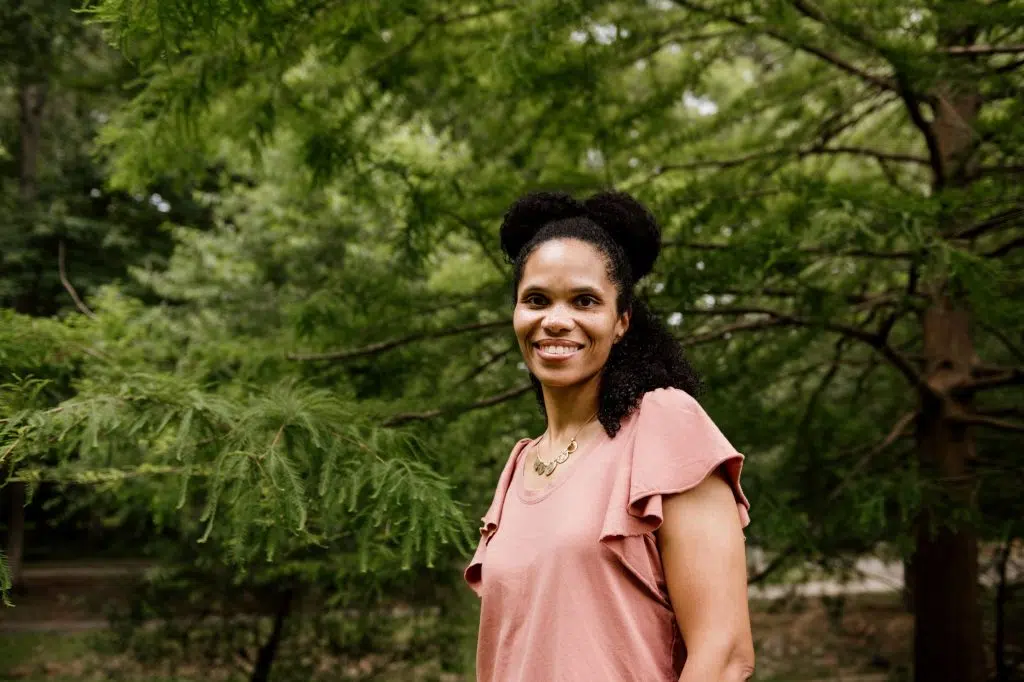
Watch my conversation with Amber Johnston
Prefer to listen to your content? Subscribe to Homeschool Conversations on Apple podcasts or wherever you get your podcasts so you don’t miss a single episode!
Amy Sloan: Hello, friends. Today, I am joined by Amber O’Neal Johnston. Amber, thank you so much for joining us today.
Amber O’Neal Johnston: Oh, I’m excited to be here. Thank you for having me.
Amy: Amber fell in love with the principles of Charlotte Mason when her oldest was a preschooler. After wholeheartedly committing to follow Mason’s philosophy, she became disheartened when months went by with little mention, if any, of the stories and accomplishments of black people in her schoolroom. The literary quality of the books was better, but she found that the cultural emptiness she had experienced as a schoolgirl was being perpetuated within the walls of her own home.
Committed to bridging the gap for her four children, Amber has embarked on a journey of uniquely merging living books with life-giving books and a culturally-rich environment to ensure that their education is not a legalistic venture in Charlotte Mason but an honest experience that honors the truth while helping her children to see the value in themselves and others. Amber shares her observations on culturally-rich home education, books, travel, and more at heritagemom.com. When asked about her path, she likes to smile and say that in her house, Charlotte Mason has an Afro, which is very fun.
I have been following you on social media, I think was where I first was exposed to your writing, and have loved your book recommendations and just the wonder-filled approach to education that you communicate. I’m delighted to get to talk with you today.
Amber: Thank you so much. I’m so happy to be here.
Amy: Just here at the beginning, I know that I just gave the intro, which is always awkward. I awkwardly read the bio while I’m staring at the people. [laughs]
Amber: That’s okay.
Getting Started Homeschooling
Amy: I would love to hear a little bit about yourself and your family and then how you guys decided to start homeschooling.
Amber: Okay. Sure. Yes. I’m married to Scott. We have four kids. They are 5, 7, 9, and 11. The littles are boys, the olders are girls. Scott and I are both from the Midwest. I’m from Illinois, he’s from Ohio, but we actually met here in Atlanta. We met at the art museum which is a really fun story, who would have known. We’ve settled here in Georgia, in the suburbs out aways from the city. The children have been homeschooled from the beginning. Before that, I was a stay-at-home mom and I had my profression, I was doing what everyone else was doing.
When it came time for preschool, my girls were in a preschool program at a church near our home. It was during that year that I would say my homeschool awakening started happening.
It was actually through my husband, which is not a typical story. Yes. He is the one who began with a very strong interest in the children being homeschooled. I thought he was kidding, a lot. The first several times he brought it up, I would just giggle. I would just be like [giggles] because I just did not see that coming at all. We are both products of public school education.
My parents were both public school principals. This was just not something that was on my radar. Around that time that he was talking to me about it, now that I look back, I feel like it’s something that God was doing in my life, but what was happening was I kept running into more families who homeschool than I never had before. I would notice these women, I didn’t know they homeschooled, and I would see them interacting with their children and see their families, and I thought to myself, “Oh, there’s something I admire about this mother.” That’s what I was thinking.
Lo and behold, it kept happening, then she was like, “Oh, I home educate,” and I’m like, “What?” Yes, after a few of those, combined with my husband’s nudging, I decided to consider it seriously. I had one angel mom that I met at the park who invited me over to her house to see a day in the life, and that changed everything for me. I’ve never forgotten that. I’ve opened my home many times since then because I realized, I probably wouldn’t have done this without her.
Amy: When I was a young married mom, maybe I had a baby at this point, I can’t remember if my oldest was born. I don’t know if you know this, so I’m actually a second-generation homeschooler as is my husband. We came in knowing we wanted to homeschool, we had both had a really wonderful experience. I had just one brother, he was four years younger than I was, so I had never really experienced those little years, at least, that I could remember in my memory. I got to go over to a young mom’s house and just shadow her for the day.
I remember that being a real encouragement. We should probably do that more often in the homeschool community.
Amber: I agree or at least talk about it more because it is a sacrifice because you have somebody else in your home for the day, so maybe you’re needing to stay on schedule more or do something. It’s a sacrifice, but it’s just such a strong way of giving back because basically, you’re just letting someone in to see your style of mothering within a homeschool. It really did make a difference. I still thank her, I can barely see this woman without gushing because of what she gave me, but yes.
Cherishing Childhood with a Charlotte Mason Education
Amy: How has your approach to homeschooling and your educational philosophy grown and changed over the years?
Amber: Basically, when we first started, the main reason my husband wanted to homeschool was because he wanted to get my oldest daughter started in school right away early. So a year at preschool and he was like, “All right, when kindergarten starts in the fall…” (we were going to send them to a private Christian school) and I was like, “Well, actually, no, because she has to do pre-K now because she has a late birthday.” He was like, “What?” Typical parent, he was like, “She’s so smart, she’s so ready, she’s so capable. I can’t imagine her being held back by the powers that be.”
Amy: A typical firstborn.
Amber: Exactly. Now, I just look back and I think it’s hilarious, but that was kind of his motive. He had done some research and found that in our area that if a child was homeschooled for a couple of years, that they could then roll into the next grade with school even having that late birthday. That was his master plan. We started with that as a motive, but it quickly burned off as our main reason as I started researching and becoming more educated on early child education, home education, homeschooling.
What started as a drive for achievement and for her to be ahead and challenged and all of these things morphed into almost the polar opposite of now homeschooling wanting to cherish a slow childhood and feeling it a privilege to be able to not hold her back but to just let her be.
I’m really thankful that early on, in our first year– so that year of preschool, I was researching the whole time knowing that we would probably homeschool. Just during that year to have met so many different voices online and through books that spoke that same message to me, again.
I had been reading Last Child in the Woods by Louv, and then I’m encountering the writing of Charlotte Mason during that year, and he’s talking about the problems with children who aren’t in nature. She’s talking about spending time outside and delaying formal academic education until the child’s a little older.
When it all shook out, I was prepared to move into a Charlotte Mason style of homeschooling from the very beginning using her principles in our homeschool. That’s where we started. I knew I wanted to do a literature-based approach to homeschooling and that’s where I ended up, and I’ve been doing that ever since.
Amy: As I’ve talked to so many different moms in the Homeschool Conversations podcast, it’s been really fun to see how many different reasons were the initial surfacy reason for starting homeschool, but then how over the years, things have changed. I think God can bring families into home education through many different pathways and then surprises us with what we learn and how things progress as we walk alongside our kids.
Amber: I agree. I think you have what you need in the beginning, maybe whatever your family needs or whatever can see you through that first step. Then once you enter into the homeschooling world, I guess I’ll say, so many other things become eye-opening and become important and you end up, in a lot of ways, reordering what’s important to your family.
I wouldn’t have even had the vocabulary to express the things that are most important to us now, I had to get here first. I do think that that is a gift in the way that He gives you what you need at the time, and then it opens your eyes more and more to what, maybe, the message really is.
Once you’re there, He gives you exactly what you can handle at that moment.
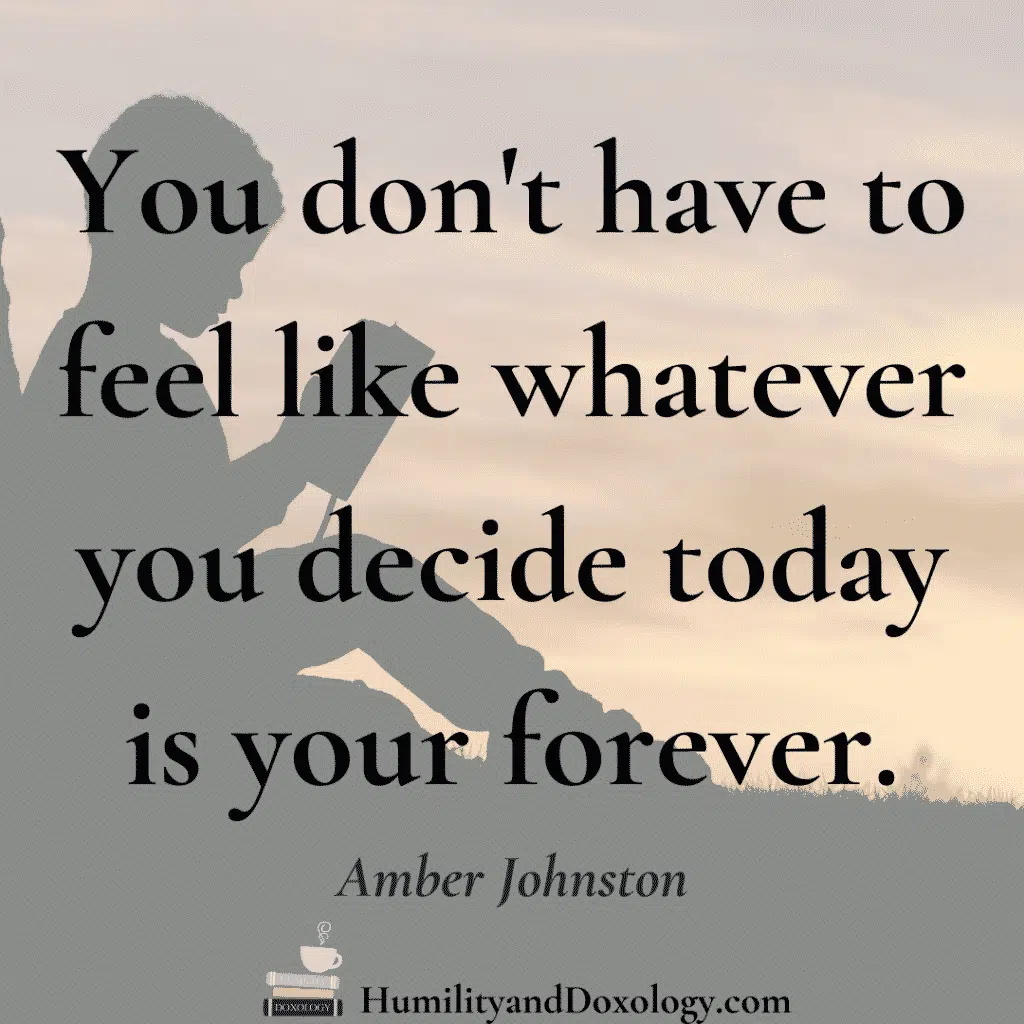
Amy: It’s a process and an adventure and you’re constantly learning and repenting and growing and you don’t have to have it all figured out. If a new homeschool mom is listening, it’s okay if you don’t have it all figured out, nobody does.
Amber: No, I totally agree. That’s actually one of the beautiful things though because you don’t– the only thing that really needs to change in order for there to be change is for you to change your mind. I’ve changed my mind about small and big things and it’s nice we have a parent-teacher conference, that’s my husband and I and we’re like, we’re going to do it this way. We’re going to change. Or we talk and we’re like, we don’t feel this way anymore. As a result of that, we’re able to actually shift things in our home.
It could be our family culture, our schedule, or whatever it is that we feel that in an area where we’ve grown. So I think that’s really good advice that you just gave like, we don’t have to feel like whatever you decide today is your forever, I have people ask me all the time, “What about high school?” I’m like, my oldest just turned 11, I think about it sometimes but I’ll figure it out, but that’s not what I spend my time– I’m going to shed multiple times before I get there, multiple times before we get there.
Amy: Yes, it’s a living thing. Well, we’ve already started talking about some of the wonderful parts of homeschooling, but what would you say is your favorite part about homeschooling?
Homeschooling Lifestyle and Schedule
Amber: Oh, definitely it’s the lifestyle and the schedule. For me, I just love the flow of how we wake up in the morning, and we have yummy hot breakfast and sometimes we start school right away, or sometimes we don’t, and we’re just playing. Or the last couple of mornings, my kids have awakened to snow, if you want to call it that, powder dust on the lawn. I know that as soon as the sun comes up, it’s going to melt away so they are getting all hats and gloves and way too much stuff more than they need, but they never get a chance to use it in Georgia.
They’ve been outside playing in the snow and that gave us a delayed start from when we normally start, I love that. I love being able to take lots of field trips to travel when we want.
When my mom comes to town, school is totally different, like she just got here, we’re not thinking about that right now. We’re just cuddling and loving on her and so I feel like school is life and life is school and it’s all intertwined and to me, that’s what I find to be most valuable.
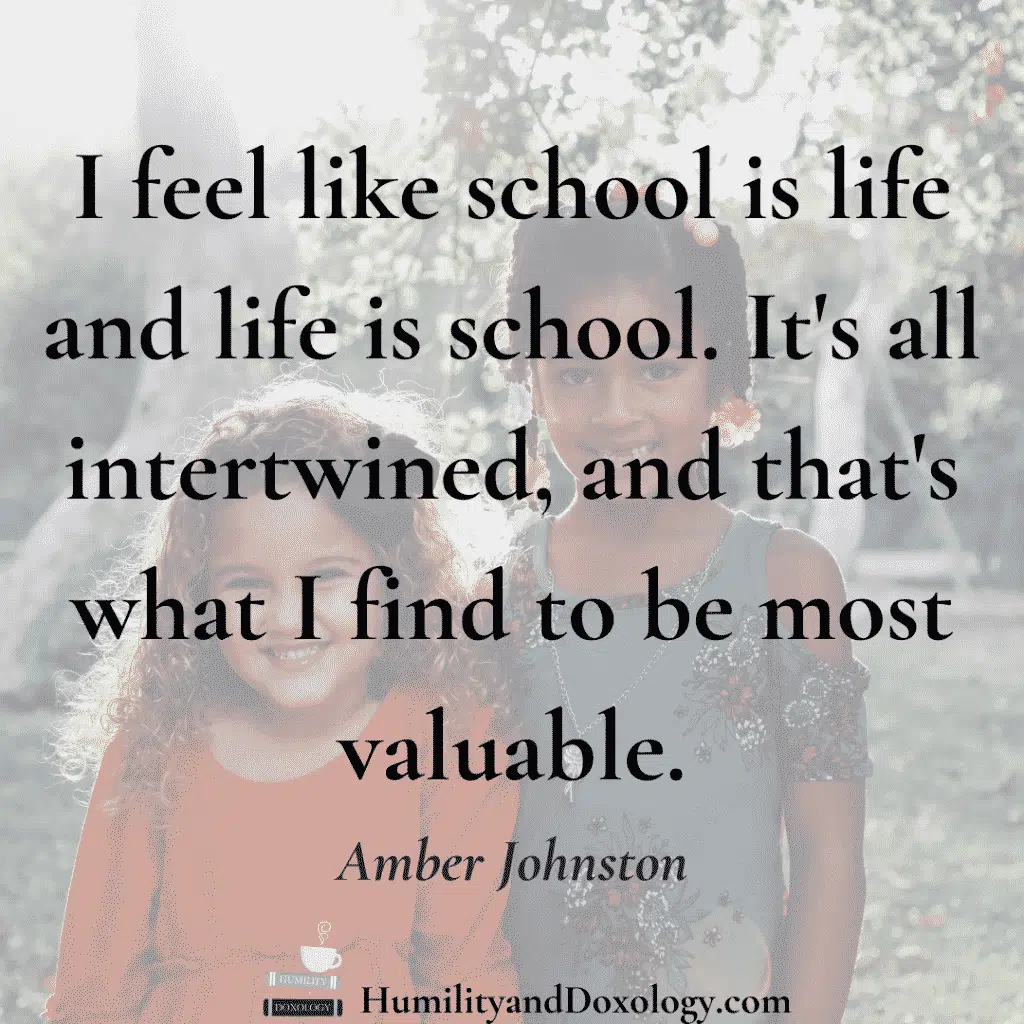
Challenges of Homeschooling
Amy: Yes, well, we all know that homeschooling is not always easy, it may be lovely, but it’s not always easy. What are some of the more challenging parts of homeschooling and how do you seek to overcome these challenges?
Amber: I think a couple of the most challenging things. One is that I have found without a doubt that the mood and spirit of my home revolves and is only dependent on one person, and that’s me, mom. It gets kind of a lot of pressure because some days I’m just not having a good day. I don’t know you call it waking up on the wrong side of the bed, maybe I stayed up too late, which is typically my issue is that those late nights when my husband and kids have gone to bed, and I’m alone, I relish that time.
Sometimes I’m not diligent and responsible about that time and getting to bed early enough and so I wake up, I’m groggy and crabby, irritable, impatient. At other times, maybe something really is going on, maybe I’ve experienced some type of loss or maybe husband and I are not seeing eye to eye and I’m not feeling him or the kids, and so whatever it may be, I realized that I have to go into for me, it’s prayer, a time of prayer and a time of reflection and really just recommitting myself some mornings to what I set out to do.
If I walk out of my room feeling that irritability and letting it show and shine through to my family, our entire day, and sometimes week spirals into what feels like out of control.
I think that that’s very difficult when I worked before, I worked in corporate America and if I was having a bad day, it was very much usually only impacting me. I might be a little quiet that day, but everything else is going on just fine, no one cares about me and my bad attitude and that’s not the case with home education.
I think one of the other things that can be difficult is that I want to give all of my children a lot of individual time because I see how they blossom when we’re spending that time one on one just snuggled up with a book or having a deep conversation and I just find that very difficult to do. I love it when it happens but so often one of my children is talking to me maybe it’s usually one of the older girls. She’s sharing her heart or telling me about a great part of a book and I’ve got someone tugging at my leg and someone’s hungry.
The phone is ringing and the repair guy’s here and I’m not able to give her what I want and so that weighs heavily on my heart. It happens a lot with homeschooling because we’re all here so intensely but I imagined an aspect of that would be the case, even if we weren’t homeschooling. I try to keep a mental note and to circle back later that evening, even if it’s hours and hours later, and say, “Earlier today, you were telling me about that your favorite part or what you just read in that book, or about a funny song you heard, and I didn’t get a chance to finish listening to it, but I’m all ears now. I’d really like to hear about the rest of it.”
I don’t always get that right but I do try, I really do try. I think those are the areas, they’re heart areas that I struggle with the most with homeschooling more so than structural areas.
Amy: It would be so easy if we could just have our little checklist and get our little academic boxes checked off, and then be like, “Oh, everything worked out well for the homeschool,” but so much of it has to do with relationship, our hearts, our children’s hearts, just the relationships, just sort of that real-life stuff. Which goes back to the best part of homeschooling, but kind of the flip side of it is it’s also the hard part, many times, at least in my family.
Amber: I totally agree, and it makes sense when you think about it, because I always think about that with my children, like the areas of my children’s personalities, that are the negative things that are just, “Ooh”, you know, I also don’t want to smash them, because I recognize those are also their strengths. The child who doesn’t want to back down, or the child that is always speaking her mind or won’t ever kind of let it go, or anything like that. I’m just like, wow, that could take you so far, though that, on one hand, we can say that it feels frustrating now, but later I can see that being described as diligence and passion and things like that.
Amy: Standing up for truth and justice and all those things we don’t want them to compromise on, like in the middle of the grocery store is not really where we want them building that but one day the Lord can redeem that.
Amber: It happens. Yes, I see this homeschool as another– yes, it has this personality and what’s good about it is also what can be difficult about it. It is the way it is, I know that everyone’s not called for this lifestyle but those of us that have been or those who think that it might be something that they would be interested in, I just feel like there’s just so many mighty blessings that come out of it, that it’s really, really hard but that should show people how mighty the blessings are. That we would be willing to walk through that much difficulty and still feel like we’re coming out ahead.
Amy: Yes, it’s 100% worth it. Sometimes I say it’s the best hard thing I do.
Amber: Yes.
Books as Mirrors and Windows
Amy: Well, Amber, one of the things you discuss on your blog and social media is this concept of books as mirrors and windows. Could you explain that idea a little bit here and explain how this has influenced the books that you choose to include in your own home school?
Amber: Sure. The idea, and I did not come up with the idea, I read about it, there was a former professor, Rudi St. Bishop at Ohio State University, and she wrote a paper about it years and years ago, and I stumbled upon it when I was in the throes of complete confusion. I was doing all the things that I had read about and that I saw other moms online doing with their homeschool, particularly moms that were following the Charlotte Mason philosophy, but it really extended beyond that, just moms in general.
I was doing our studies, and we were having lesson time, and the wonder and magic and all the things and my kids were participating and all was well, except it wasn’t. My oldest daughter really started to exhibit signs of what I feel is self-hatred, a form of self-hatred, anything related that you would think of as being related to being African American. That’s the color of her skin, curly hair, being around her family, she would even ask me, “Why am I the only person with a brown mom?” I’m like, “Because you’re brown,” what is she not understanding?
There was a lot of shame, there was a lot of confusion from her end, and I just could not figure it out. I’m just going along and I’m like, where is this coming from my husband and I never, ever talked about things like that. We never talked about race or skin color. We never talked about other people in any type of negative way so I don’t understand why she would be doing this, like a whole year.
Essentially, at the end of the day, she was able to articulate to me that we never study any black people in our school and she associated that with black people hadn’t really done anything worth studying.
It makes sense. She was young and she’s like, if they had done something we’re studying, we would have been studying it and we don’t ever study black people. When she said that I was like, so true. It’s so true. Then I went through this time of humiliation or embarrassment, because how could I as a black mother, not have thought of that. I realized, I also am a product of an education that didn’t reflect me. It didn’t stand out to me immediately that things could be different, or that things should be different.
I was a much more complacent child so I never would have said anything. I never did say anything. I just thought this is what education in America is and she is not a complacent child so she is like, “Hey, what’s up there’s no people at all that look like me in any of these books.” She didn’t like it.
God used her to wake me up, and there’s nothing that can wake a mother up than the pain of her child. I started really digging in and studying and that’s where I came across this concept of books being mirrors that reflect back to a child.
Reflecting through words through the illustrations, because she was really young so part of it were the pictures in the books. Just to clarify, it’s not that we didn’t have any books with any black characters, they were on the shelf, and sometimes we would read them at bedtime and things like that, but they were on our fun shelf, they weren’t a part of school. That’s a big difference. The pictures of girls with big hair, who had grandmas that were come in, and maybe those grandmas were humming songs, while they’re making cornbread and things that felt familiar to our family, she wasn’t seeing those things.
In our history, we weren’t reading about anybody at all that really wasn’t white, and so that set off an idea in my head. Here’s a child who’s in pain. She’s expressed to me, amazingly, of what’s missing in her life, and here’s this concept that I could use to help me frame what was happening. I just dug in from there. My study, in terms of building our home library and changing our homeschool curriculum, was really rooted and helping her to see herself reflected in our schoolbooks.
Now, that wasn’t a complete overhaul, because sometimes I’ve heard all the positive feedback, I’ve also heard the negative feedback like, “Well, isn’t that wrong, you just changed everything to be black?” I’m like, “No, not everything.” That’s silly. That’s very black and white thinking.
I didn’t change everything. I changed some things, so when we read biographies, we include biographies about black people. They’re not all black, but a lot of them. In the Charlotte Mason education, you study musicians and composers, and you study great artists, and I include black people in those things.
In historical fiction, we like to read about what black people were doing at the time too, and in our nonfiction history as well and in poetry, and just everything. I didn’t wholly replace anyone as labeling good or bad or get out with the old and with the new. It was more a scoot over and make room for us at the table.
Amy: It wasn’t a narrowing. It was an opening, it was going bigger, not somehow going smaller.
Amber: Right, that’s it, and that didn’t mean I had to take some things away, because let’s say you’re studying three artists in a year, then yes, I’m taking out one or two of the white artists and I’m replacing them with other people but still there’s no formula for it. Sometimes like right now we’re studying medieval times and the Middle Ages. Help me, it’s been a rough time. I have some history books we’ve been studying what’s going on in African kingdoms and things like that, but music and art from black people during the Middle Ages? Yes, that hasn’t been going so much so like that.
This is a term where you would say, we aren’t doing as much of that across the board, but I also infuse people from other time periods, but we just make it work. It’s really a dance, it’s not a formula and I just dance with it.
Sometimes we pull from here, sometimes we pull from there and the whole time, the idea being that the world is full of people, we love them all, including ourselves. We can just dance from one to the other and just cover it all as humanity.
Amy: I love that you were able to listen to your daughter, and what a gift that she was able to articulate at such a young age, that’s a gift that she was able to verbalize what she was thinking and feeling and that you had the heart to listen to her. Then, like you said, not coming up with a formula, a checklist, but again going to the same thing that keeps coming up. Education is this living thing, this growing thing, this just relational thing and it was very much about that, which I love.
Amber: That’s exactly what happened.
Book Recommendations
Amy: Well, are there any books or authors that you guys have come to love or that you’ve realized seem to be missing or ignored that we should be adding to our library hold lists?
Amber: Well, our favorite author is Patricia McKissack and I’ve never really seen any of her books on any list. She, unfortunately, passed away some years ago, but she was a very prolific writer. She often wrote with her husband, Fred McKissack, and so sometimes you’ll see both names on there. They had an array of fiction and nonfiction and I’ve read some interviews from before she passed and she talked about basically, she wanted to provide a body of work that was exactly what my family needed. She talked about how these stories were being told, and that she set out to spend her life telling them and she did.
I’m not a book collector, people are often surprised at that. I talk about books a lot and I recommend books a lot, I’m not actually collecting them. I’m getting them to use with my kids, but I do collect her books because we’re trying to get all of them that we can. A lot of them are out of publication, so that’s that one author that I follow. She has some books about life during the time periods of enslavement, but then before that, and the greatness of major African kingdoms of like Mali and Sanghay. She has so many beautiful stories like storybooks, full of stories that really speak to the African American experience in a beautiful, beautiful way so I can’t say enough about her.
Amy: I will definitely have to check and see if we have her books in our library. I don’t remember hearing her name.
Amber: You may have, though. A long time, we had been reading here and there books by her and I just wasn’t aware. I don’t always pay as much attention to the author and illustrator as I probably should. I’m just moving along, like, “This is a great story, let’s read it.” After a while, we kept saying we really liked this book, and we really liked this book. I think it was one of my girls who made the connection. They’re like, “Mommy the same person wrote this book.” We started paying attention and I realized like, “Oh, wow. She’s written so much.” I’ll be interested for you to check it out and see what you think.
Amy: Another thing I find with this, like you were mentioning the authors that, “It’s the same author of the book.” Something that I will end up going on rabbit trails is I’ll follow the illustrator. If you find the illustrator of a book, you’re like, “I love the way they’re depicting this story,” you can search for the illustrator in your library system and discover new favorites, and then you find new authors, and then you get down those rabbit holes. Rabbit trails are very fun.
Amber: That is so true.. I just posted, I recommended a holiday Christmas list and there’s a book on there where Patricia McKissack wrote it and Jerry Pinkney illustrated. Jerry Pinkney is one of our favorite illustrators and so when I found that book, I was like, “What? Just like the two of the teaming up. Why am I surprised? I shouldn’t be surprised.” You’re right. Then you follow the Jerry Pinkney rabbit hole and find a bunch of things, so that’s been it.
I think it’s really important, I’d like for moms to know that I’m not a historian. I am not an expert.
Our home library was born out of necessity and just sprinkled with a whole lot of love and I’m learning as I go along. I can say today, Oh, I love Jerry Pinkney, I love Patricia McKissack we can say, but like six years ago, I had no idea who either of those people were. Be kind to yourself and patient as you get into a rhythm with your family and start to naturally develop your favorites. You don’t have to run out and try to learn everything and know everything and you get recommendations from friends and you just land naturally where you’re going to be. It doesn’t have to be a forced thing.
Amy: That’s a really good wise word there.
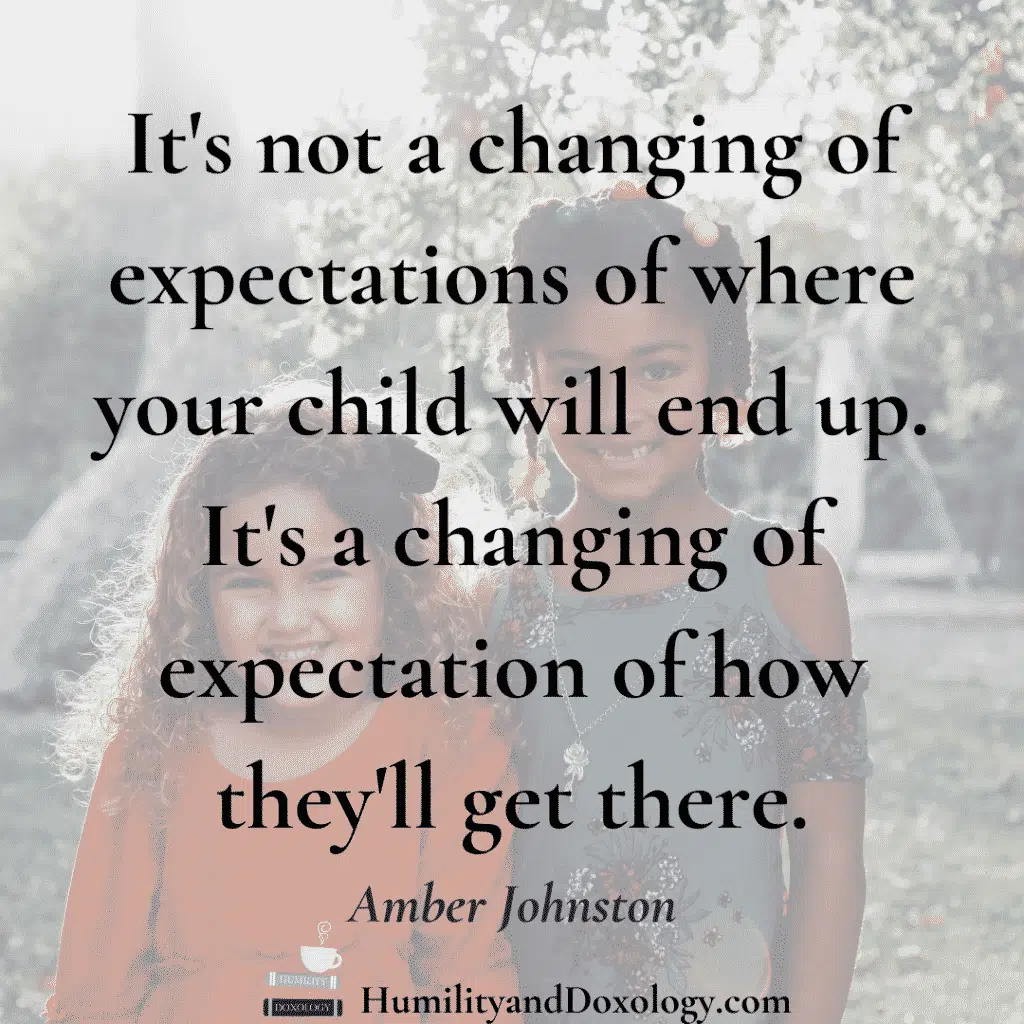
Slow, Wonder-Filled Childhood
Changing gears a little bit, and this came up in the beginning of our conversation because of your changing ideas about early education. One of the things I just love, I love the stories you will share on social media and pictures of your boys, and this slow beautiful, wonder-filled childhood that you are trying to give them. I’m just imagining, maybe a mom of littles is listening, and there can be a lot of pressure sometimes to achieve something great or do some sort of big thing as a mom of littles. Can you just talk a little bit about the value of a story-saturated life and that more slow childhood?
Amber: Absolutely. I’m trying to give my children something that– I had a wonderful childhood. What I’m looking at now and trying to gift to the children is something that is really simple but very hard. It’s not complicated, but it’s extremely hard because I’m trying to pull back and resist the urge to pace my children against other children. That can be so difficult because from the moment our children are born, we’re like, ”When did they crawl? What percentile are they? How long did you nurse? When did they walk and say their first words?”
We’re pacing, right? The whole baby book concept is set up to record all the milestones that are pacing. Your pediatrician appointments are pacing. I am fighting against that mentality to just let them be. Now, before I got into that, I’m going to tell you, I had to read a lot of books about that because at first, I was like, ”I don’t know about that. Just be what, though?” I had a lot of misconceptions like, ”Does this mean this child just runs free and misbehaves and acts crazy? When are they going to learn their ABCs and their math? I don’t want my kid to be behind,” and all of that.
I did a lot of reading and then I did a lot of praying, and it sat well with me. It sat well with me the same way a mother knows when to pick her baby up and when to let him fuss a little bit. A mother knows what each cry is. As I thought about this kind of wonder-filled slow childhood, I felt like this was something for my kids.
Basically, we don’t begin formal academics until around six. For me, it’s not exactly when they turn six, on their sixth birthday, but I usually start the school year after they turned six, just giving them as long as possible to be let alone, I guess I would call it.
That’s a lot of time spent playing outside but also a lot of time underfoot with me and the siblings exploring things, making things. We read a lot, and tell stories, read stories. It’s almost like what parents do, maybe stay-at-home moms do, with their kids before they put them in school, but I’m still doing that. We’re still living that extended baby preschool period. They’re growing though, they’re not stunted in preschool life, but they get all that they want and need. They pull from it and I provide what it is that they’re pulling or what they’re seeking or searching for.
Amy: It’s not necessarily measurable in a worksheet kind of way, but they’re still growing in it. They’re not just feral children in the neighborhood.
Amber: No, not at all. We have family rules and expectations, and they have work; they have chores that they’re doing and work that they have to contribute to the home. I feel like this type of thing, what I’m talking about, it really only works in a learning-rich environment. The idea is that they’re soaking up many of the same things that would be on a checklist, but it’s done naturally and through play, and just through experience, a lot of conversation. I talk all day long: “I’m going to mix up the pancakes. I was thinking I could use an instant pancake mix today, but instead, I’m just going actually pour all the dry ingredients and make them from scratch this time because daddy likes it like that. Let’s grab the flour. Man, it got ground up from the wheat outside. Grab the sugar,” and so on. A lot of narrating as I go about my day, so they learn a lot through that and reading, interacting with the siblings, and we do. My kids know stuff, but I didn’t set out to do it.
I think one thing that really helped spur me on is in our state, children are required to do standardized testing every three years. My oldest, when she got to third grade, it’s starting in third grade, is when it has to start, I was just like, ”I’ll just do this because it’s a lot, whatever. I’m not going to care about it, whatever. I know I haven’t been teaching her that stuff. It’s going to be fine. I don’t care what it says.” She sat down and just like, ”Blah, blah, blah.” I was like, ”What?” I was like, ”Okay, wait, I don’t care about these things. I’m so above this.” I was like, ”This childhood of her just living, we go places in the community and people talk to her, and she’s learning, and look at that. Look at that.”
I thought to myself, there’s something here. There is a body of knowledge, I guess, that we would like kids to get around in such and such time, and kids get really close to that target without the pressure, without it. They get really close. I have one that– she goes like this. She gets in, and she looks like she doesn’t, and I’m wondering, ”Oh, my gosh, do I need to shut my blog down? I don’t know what I’m talking about.” Then, the next thing you know I turn around, and she totally has it. It’s fine.
I think it’s not a changing of expectations of where your child will end up, it’s a changing of expectation of how they’ll get there.
Amy: I love what you just said. That is so fantastic. It’s something I am really passionate about encouraging moms, especially with the preschool years and kindergarten in particular. Different children will be ready to start more formal academic at a variety of times because children are individuals. It’s so important to me to just communicate to these mamas of these precious little ones, read with them, talk with them, be with them, give them the curiosity, and the wonder, and the imagination. That is going to be so valuable.
Earlier this week, my little five-year-old, who’s my youngest guy, too, he was setting the table with forks. He’s standing in there at the drawer, and he says, ”Mommy, how many people are in our family?” I said, ”Well, how many children are in our family?” He said, ”Five.” ”How many parents?” He said, ”Two.” I said, ”Okay, so how many do you think that is all together?” He’s thinking for a minute, and he figures it out, ”It’s seven.” Then he has the three small forks and the three big forks in his hand, in each hand, and he says, ”Is this enough?”
I said, ”Well, how many do you have?” We were just walking this, it’s very natural, we’re just in the kitchen talking about the forks, and he’s figured out now addition, greater than, less than, subtraction, how many more he needs. That is without pressure. This is part of normal life, and you’re developing that love and curiosity. You don’t know the answer? I’m not going to tell you the answer. Let’s ask questions and figure it out.
Amber: That’s a perfect example. That’s exactly what I was going to say because I think that sometimes a misconception when I’m talking, people are like, ”You just don’t teach your kids anything? They just walk around playing with Play-Doh all day?” I’m just like, ”No.” I’m not saying it correctly, but that is a perfect example. They are learning. I am teaching them. It’s just that it’s coming about naturally, and it always does. Again, at a different pace. Like you said, different times. That’s the part that the mom has to be willing to live in that tension and discomfort if we’re used to coming from a system where there is no latitude, you’d know this by this time.
I guess I would say what I’ve seen with children is they don’t know all of those at this time, but they sometimes know way more, and then sometimes they don’t know something yet. Then they get it next year or tomorrow. Again, I feel like this works in a learning-rich environment because that’s another time I’ve seen some environments where this probably wouldn’t work. I’m not talking about a child that sits alone all the time or doesn’t have people pouring into them, but in these learning-rich environments, the kids pick it up so quickly.
Amy: Although, full disclosure, my five-year-old also really loves Ninjago.
Amber: Yes, do we want to go there? That’s for sure. I remember posting something, and people really got a kick out of it. I’m like, ”No, this is really real.” My boys woke me up super early one morning, and they were already packed up for camping. This was several months ago. I’m sorry, not camping, for skiing. This was several months ago, and we weren’t going until January, it’s usually when we ski. I was like, ”Okay, next time, turn down that wild and free vibe and go in the basement and turn on Netflix until mommy gets up.” There’s a realness to that as well, but I think that’s what’s great about it. It’s like we are—
My kids live in the real world. They are in a little bit of what some people call a bubble. I’ve renamed it as a love incubator. They are in my love incubator.
Amy: Yes, I’m stealing that.
Amber: Please do, because I’ve heard that so much, “Oh, it’s a bubble.” I’m like, love incubator. Within that, they very much are still experiencing the things that all little boys experience and enjoying that.
Amy: I can’t wait to tell my teens that they’re in my love incubator.
Amber: They’ll love that.
Amy: They’ll love it.
What Amber Johnston is reading lately
Well, Amber, here’s the end, I’m going to ask you two questions. I’m asking all my guests in season three. The first one is just what are you reading lately?
Amber: Okay, I am in a series of pre-reading mode, trying to get on top of some things for my oldest child. This is going to sound really, really crazy, because normally, I’m not reading this, but I’m reading Twelfth Night from Shakespeare right now. I’m not going to lie, that’s not my choice of what I would like to be especially reading.
I’m just starting a book by an author. She’s Nigerian, and I don’t want to mess up her name. I’m going to send that to you. The protagonist in the book is a little bit older than my daughter and so I want to make sure that it’s an appropriate level for her. [Purple Hibiscus, by Chimamanda Ngozi Adichie]

We’re also in the midst of Ann Voskamp’s Advent book, The Greatest Gift I think, that we’ve ever received. I’m bad at titles, but we’re on day two of that book as well. Just kind of a little bit here and there are a lot of different things.
Amy: With Twelfth Night, the Shakespeare, I always recommend audiobook version, like the audio drama or something because Shakespeare is not meant to be read. If you try to just read it like a book, it’s not as much fun.
Amber: We have all those Arkangel recordings, which are really, really good, the music and all that.
Amy: Yes. The Comedy of Errors one, David Tennant is one of the protagonists and my kids knew him not from Doctor Who at the time, but they knew him from– he was also the narrator for the How To Train Your Dragon series.
Amber: Oh, cool.
Amy: When we turned on the Shakespeare play, they were like, “Oh, we know his voice.” It was very exciting.
Amber: Oh, yes. That’s so funny. Yes, they love that.
Encouragement for the homeschool day going off the rails
Amy: Well, the final question is just what advice or encouragement would you give to a mama whose homeschool day seems to be going completely off the rails?
Amber: I would say, take some time off. That’s never a bad thing. Look at what is giving you life and what’s going well, and how you can maybe protect that or do more of it, maybe you don’t need to do more, maybe it’s just a protection of that. Look at what isn’t going well and decide whether it’s worth fixing or if it’s something you need to throw away, or just put away. Some things I still am planning to implement, but they’re put away right now because this wasn’t my season for that. Some things I’ve thrown away. I’m just not going to do those things ever probably.
Prioritizing and then looking at what’s worth fixing right now and looking for a new way of doing them. I read one author who said that, “A change is as good as a break,” or something similar. Sometimes it’s just changing the way that you’re doing something that could make it feel refreshing again. First, I just think a reset is sometimes in order. As homeschool moms, we often feel like we have to be doing school, like it’s school, school, school, or this is not a planned break or, “but if I take a week off now then how do I get that week back later.”
I’m just like, just stop. Even though you’re not going to the beach or to Disney or go see grandma, just have a staycation of your mind in your own home. Take some time and figure out where you want to go and how best to get there. Chances are there are some things that maybe you’ve been trying to do that is just too much and that it’s okay to put something in a parking lot. It doesn’t mean that you’ll never do it with your children and just cut back and cut back and cut back as– Oh my gosh, I forget her name right now, but there’s a book where she says, “Cut back until you have peace. Keep cutting back until you have peace.”
Amy: That is such an encouragement. Actually, I kind of needed to hear that today. That reminder that saying not right now, putting something to the side, doesn’t mean you’re giving up or you’re saying you’re never going to do it. I think sometimes it’s just hard to give yourself that space to put it to the side and not feel like you’re giving up and that was an encouragement, so, thanks.
Amber: You’re welcome, thank you.
Find Amber Johnston Online
Amy: Amber, where can people find you all around the internet?
Amber: Oh, well, I blog at heritagemom.com. I put lots of book recommendations and other things there. I’m really active on Instagram @heritagemomblog. I also have a Heritage Mom Facebook page, if you’re not on Instagram, and I have a pathetic YouTube page, if you can find it. That’s my gift to you all like eight videos maybe. Someday I’ll get back to that. That’s on my not-right-now shelf. That’s pretty much where I hang out online.
Amy: I’ll put links to all those things, including the mysterious YouTube channel in the show notes for this episode over at www.humilityanddoxology.com. Thanks so much for chatting with us today.
Amber: Well, thanks for having me. I appreciate it.
Check out all the other interviews in my Homeschool Conversations series!
